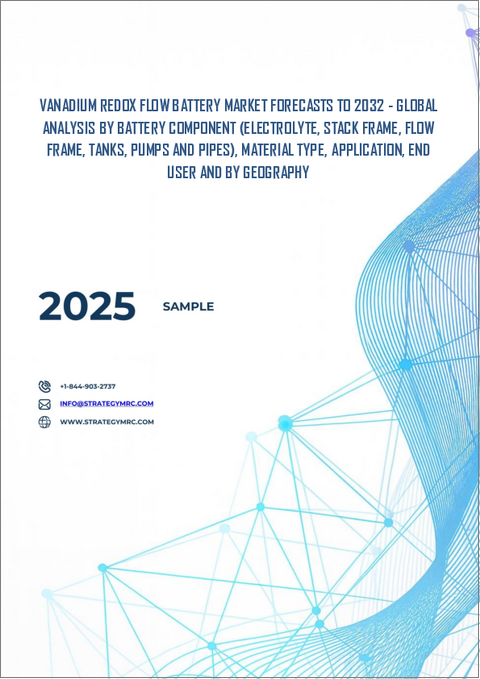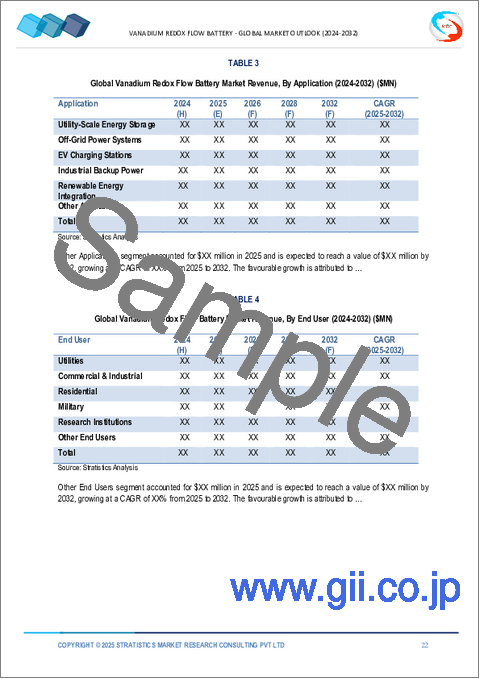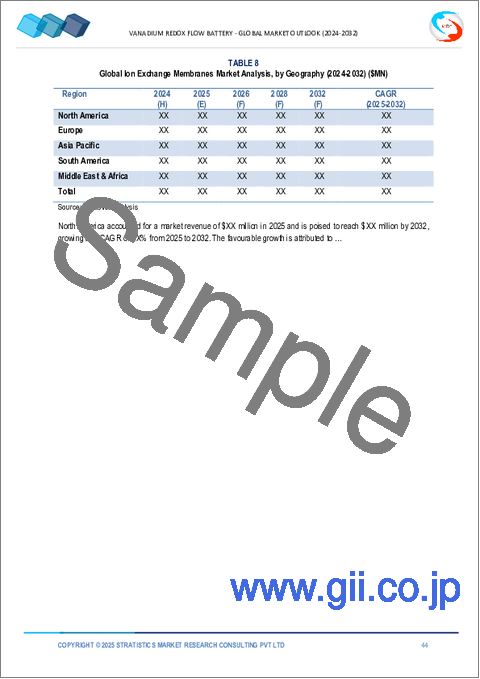|
|
市場調査レポート
商品コード
1766077
バナジウムレドックスフロー電池市場の2032年までの予測: 電池コンポーネント、材料タイプ、用途、エンドユーザー、地域別の世界分析Vanadium Redox Flow Battery Market Forecasts to 2032 - Global Analysis By Battery Component (Electrolyte, Stack Frame, Flow Frame, Tanks, Pumps and Pipes), Material Type, Application, End User and By Geography |
||||||
カスタマイズ可能
|
|||||||
| バナジウムレドックスフロー電池市場の2032年までの予測: 電池コンポーネント、材料タイプ、用途、エンドユーザー、地域別の世界分析 |
|
出版日: 2025年07月07日
発行: Stratistics Market Research Consulting
ページ情報: 英文 200+ Pages
納期: 2~3営業日
|
全表示
- 概要
- 図表
- 目次
Stratistics MRCによると、バナジウムレドックスフロー電池の世界市場は2025年に3億6,630万米ドルを占め、2032年には11億3,260万米ドルに達すると予測され、予測期間中のCAGRは17.5%です。
バナジウムレドックスフロー電池(VRFB)は、異なる酸化状態のバナジウムイオンを含む液体電解質にエネルギーを貯蔵する充電式フロー電池の一種です。従来型電池とは異なり、VRFBは電解液を外部タンクに貯蔵することで電力とエネルギーを切り離し、独立系スケーリングを可能にしています。この設計により、卓越した拡大性、長いサイクル寿命(1万5,000~2万サイクル)、不燃性電解液による高い安全性、最小限の自己放電が実現します。VRFBは、送電網の安定化や再生可能エネルギーの統合など、大規模で長期間のエネルギー貯蔵用途に特に適しています。
世界経済フォーラムによると、電気自動車(EV)の世界販売台数は2021年から55%増加し、2022年には1,050万台に達します。
再生可能エネルギーの統合
太陽光や風力といった再生可能エネルギーの導入は、バナジウムレドックスフロー電池(VRFB)産業の成長を加速させています。これらのエネルギー源は不安定な性質を持つため、VRFBは大規模エネルギー貯蔵のための信頼できる選択肢を提供し、電力の安定供給を可能にします。VRFBは寿命が長く、拡大性があり、頻繁な充放電サイクルを管理できるため、送電網の安定と再生可能エネルギーの統合に最適です。国際市場におけるVRFBの導入は、サステイナブルエネルギーシステムに対するニーズの高まりに後押しされています。
高額な初期投資
バナジウムレドックスフロー電池(VRFB)市場の成長には、高額な初期投資が大きな障壁となっています。システム設置、バナジウム電解液、インフラ開発に関連する初期費用は、他の電池技術に比べてかなり高いです。この経済的負担は、小規模なエネルギー供給業者や新興市場がVRFBソリューションを採用する意欲を削ぐため、長期的な性能の優位性があるにもかかわらず、普及が妨げられ、市場全体の拡大が遅れることになります。
技術の進歩
技術の進歩がバナジウムレドックスフロー電池(VRFB)市場の成長を大きく後押ししています。電解液配合、スタック設計、システムインテグレーションの革新により、VRFBのエネルギー効率、貯蔵容量、寿命が向上しています。こうした改良により、VRFBは大規模な再生可能エネルギー貯蔵や系統安定化に適しています。さらに、自動化と遠隔モニタリングシステムの進歩により、運用コストが削減され、システムの信頼性が向上しています。その結果、VRFBは実用規模や産業用途でますます魅力的になり、市場の拡大に拍車をかけています。
バナジウムコストと供給リスク
バナジウムレドックスフロー電池(VRFB)市場は、バナジウムの高コストと供給リスクによるマイナス影響と抑制要因に直面しています。価格変動、限られた世界サプライヤー、地政学的依存は、メーカーと投資家に不確実性をもたらします。こうした課題は製造コストを上昇させ、他の電池技術に比べてVRFBの競合力を低下させています。その結果、プロジェクト開発者はVRFBの採用をためらい、大規模展開と開発の妨げになる可能性があります。
COVID-19の影響
COVID-19の大流行は当初、サプライチェーンの中断、産業活動の低下、再生可能エネルギープロジェクトの遅延により、バナジウムレドックスフロー電池(VRFB)市場を混乱させました。製造業の減速と物流の制限により、部品の入手が妨げられました。しかし、政府が経済再生のためにグリーンエネルギー投資を重視し、VRFBのような長寿命エネルギー貯蔵ソリューションの需要を押し上げたため、市場は回復し始めました。この変化は、パンデミック後のサステイナブルエネルギーインフラにおけるこの技術の役割を浮き彫りにしました。
予測期間中、研究機関セグメントが最大となる見込み
継続的な技術革新と技術進歩により、研究機関はバッテリーの効率、拡大性、寿命を向上させています。材料の最適化とコスト削減戦略における努力により、VRFBはより商業的に実行可能なものとなっています。さらに、学術界と産業の強力な協力関係が製品開発と展開を加速し、世界中のグリッド規模のエネルギー貯蔵、再生可能エネルギーの統合、脱炭素化構想におけるVRFBの採用拡大を促進しています。
予測期間中、バイポーラプレートセグメントのCAGRが最も高くなる見込み
予測期間中、バイポーラプレートセグメントは、システム効率と耐久性を高めるため、最も高い成長率を記録すると予測されます。バイポーラ・プレートは、均一な電流分布と内部抵抗の最小化に重要な役割を果たし、エネルギー出力の向上と電池寿命の延長につながります。黒鉛複合材料や導電性ポリマーなどの材料の進歩により、コストが削減され、性能が向上しているため、大規模エネルギー貯蔵アプリケーションでの採用が促進され、公益事業や産業部門全体で市場の成長が加速しています。
最大のシェアを占める地域
予測期間中、アジア太平洋のは、再生可能エネルギーへの投資と送電網近代化構想の高まりにより、最大の市場シェアを占めると予想されます。中国、日本、韓国のような国々は、クリーンエネルギー目標をサポートし、グリッドの安定性を確保するために、大規模なエネルギー貯蔵ソリューションを積極的に採用しています。政府の奨励策、急速な工業化、無停電電力供給に対する需要の増加が、市場の拡大をさらに後押ししています。この地域の強固な製造基盤も、VRFB技術の開発と展開に貢献しています。
CAGRが最も高い地域
予測期間中、北米の地域が最も高いCAGRを示すと予想されます。同地域は、送電網の安定性を向上させ脱炭素化目標を達成するためにエネルギー貯蔵技術に力を入れており、VRFBの需要が増加しているためです。技術開発、規制の枠組み、政府のインセンティブはすべて、商用と公益事業部門での採用を促進しています。さらに、重要な企業や研究機関の存在によって技術革新が促進され、北米のにおける市場全体の成長を加速させています。
無料のカスタマイズサービス
本レポートをご購読の顧客には、以下の無料カスタマイズオプションのいずれかをご利用いただけます。
- 企業プロファイル
- 追加市場参入企業の包括的プロファイリング(3社まで)
- 主要企業のSWOT分析(3社まで)
- 地域セグメンテーション
- 顧客の関心に応じた主要国の市場推定・予測・CAGR(注:フィージビリティチェックによる)
- 競合ベンチマーキング
- 製品ポートフォリオ、地理的プレゼンス、戦略的提携による主要企業のベンチマーキング
目次
第1章 エグゼクティブサマリー
第2章 序文
- 概要
- ステークホルダー
- 調査範囲
- 調査手法
- データマイニング
- データ分析
- データ検証
- 調査アプローチ
- 調査資料
- 一次調査資料
- 二次調査資料
- 前提条件
第3章 市場動向分析
- イントロダクション
- 促進要因
- 抑制要因
- 機会
- 脅威
- 用途分析
- エンドユーザー分析
- 新興市場
- COVID-19の影響
第4章 ポーターのファイブフォース分析
- 供給企業の交渉力
- 買い手の交渉力
- 代替品の脅威
- 新規参入業者の脅威
- 競争企業間の敵対関係
第5章 世界のバナジウムレドックスフロー電池市場:電池コンポーネント別
- イントロダクション
- 電解質
- スタックフレーム
- フローフレーム
- タンク
- ポンプ
- パイプ
第6章 世界のバナジウムレドックスフロー電池市場:材料タイプ別
- イントロダクション
- バナジウム電解液
- イオン交換膜
- 電極
- バイポーラプレート
- 集電装置
- その他
第7章 世界のバナジウムレドックスフロー電池市場:用途別
- イントロダクション
- 実用規模のエネルギー貯蔵
- オフグリッド電力システム
- EV充電ステーション
- 産業用バックアップ電源
- 再生可能エネルギーの統合
- その他
第8章 世界のバナジウムレドックスフロー電池市場:エンドユーザー別
- イントロダクション
- 公益事業
- 商業・工業
- 住宅用
- 軍事
- 研究機関
- その他
第9章 世界のバナジウムレドックスフロー電池市場:地域別
- イントロダクション
- 北米
- 米国
- カナダ
- メキシコ
- 欧州
- ドイツ
- 英国
- イタリア
- フランス
- スペイン
- その他の欧州
- アジア太平洋
- 日本
- 中国
- インド
- オーストラリア
- ニュージーランド
- 韓国
- その他のアジア太平洋
- 南米
- アルゼンチン
- ブラジル
- チリ
- その他の南米
- 中東・アフリカ
- サウジアラビア
- アラブ首長国連邦
- カタール
- 南アフリカ
- その他の中東・アフリカ
第10章 主要開発
- 契約、パートナーシップ、コラボレーション、ジョイントベンチャー
- 買収と合併
- 新製品発売
- 事業拡大
- その他の主要戦略
第11章 企業プロファイリング
- VRB Energy Inc.
- Invinity Energy Systems
- Sumitomo Electric Industries, Ltd.
- H2, Inc.
- Rongke Power
- UniEnergy Technologies
- StorEn Technologies Inc.
- VoltStorage
- Avalon Battery
- Redflow Limited
- Sinergy Flow S.r.l.
- Solibra Energy Storage Technologies GmbH
- VanadiumCorp Resource Inc.
- VFlow Tech
- Volterion
- Primus Power
- Dalian Rongke Power Company, Ltd.
- Largo Inc.
List of Tables
- Table 1 Global Vanadium Redox Flow Battery Market Outlook, By Region (2024-2032) ($MN)
- Table 2 Global Vanadium Redox Flow Battery Market Outlook, By Battery Component (2024-2032) ($MN)
- Table 3 Global Vanadium Redox Flow Battery Market Outlook, By Electrolyte (2024-2032) ($MN)
- Table 4 Global Vanadium Redox Flow Battery Market Outlook, By Stack Frame (2024-2032) ($MN)
- Table 5 Global Vanadium Redox Flow Battery Market Outlook, By Flow Frame (2024-2032) ($MN)
- Table 6 Global Vanadium Redox Flow Battery Market Outlook, By Tanks (2024-2032) ($MN)
- Table 7 Global Vanadium Redox Flow Battery Market Outlook, By Pumps (2024-2032) ($MN)
- Table 8 Global Vanadium Redox Flow Battery Market Outlook, By Pipes (2024-2032) ($MN)
- Table 9 Global Vanadium Redox Flow Battery Market Outlook, By Material Type (2024-2032) ($MN)
- Table 10 Global Vanadium Redox Flow Battery Market Outlook, By Vanadium Electrolyte (2024-2032) ($MN)
- Table 11 Global Vanadium Redox Flow Battery Market Outlook, By Ion Exchange Membranes (2024-2032) ($MN)
- Table 12 Global Vanadium Redox Flow Battery Market Outlook, By Electrodes (2024-2032) ($MN)
- Table 13 Global Vanadium Redox Flow Battery Market Outlook, By Bipolar Plates (2024-2032) ($MN)
- Table 14 Global Vanadium Redox Flow Battery Market Outlook, By Current Collectors (2024-2032) ($MN)
- Table 15 Global Vanadium Redox Flow Battery Market Outlook, By Other Material Types (2024-2032) ($MN)
- Table 16 Global Vanadium Redox Flow Battery Market Outlook, By Application (2024-2032) ($MN)
- Table 17 Global Vanadium Redox Flow Battery Market Outlook, By Utility-Scale Energy Storage (2024-2032) ($MN)
- Table 18 Global Vanadium Redox Flow Battery Market Outlook, By Off-Grid Power Systems (2024-2032) ($MN)
- Table 19 Global Vanadium Redox Flow Battery Market Outlook, By EV Charging Stations (2024-2032) ($MN)
- Table 20 Global Vanadium Redox Flow Battery Market Outlook, By Industrial Backup Power (2024-2032) ($MN)
- Table 21 Global Vanadium Redox Flow Battery Market Outlook, By Renewable Energy Integration (2024-2032) ($MN)
- Table 22 Global Vanadium Redox Flow Battery Market Outlook, By Other Applications (2024-2032) ($MN)
- Table 23 Global Vanadium Redox Flow Battery Market Outlook, By End User (2024-2032) ($MN)
- Table 24 Global Vanadium Redox Flow Battery Market Outlook, By Utilities (2024-2032) ($MN)
- Table 25 Global Vanadium Redox Flow Battery Market Outlook, By Commercial & Industrial (2024-2032) ($MN)
- Table 26 Global Vanadium Redox Flow Battery Market Outlook, By Residential (2024-2032) ($MN)
- Table 27 Global Vanadium Redox Flow Battery Market Outlook, By Military (2024-2032) ($MN)
- Table 28 Global Vanadium Redox Flow Battery Market Outlook, By Research Institutions (2024-2032) ($MN)
- Table 29 Global Vanadium Redox Flow Battery Market Outlook, By Other End Users (2024-2032) ($MN)
Note: Tables for North America, Europe, APAC, South America, and Middle East & Africa Regions are also represented in the same manner as above.
According to Stratistics MRC, the Global Vanadium Redox Flow Battery Market is accounted for $366.3 million in 2025 and is expected to reach $1132.6 million by 2032 growing at a CAGR of 17.5% during the forecast period. A Vanadium Redox Flow Battery (VRFB) is a type of rechargeable flow battery that stores energy in liquid electrolytes containing vanadium ions in different oxidation states. Unlike traditional batteries, VRFBs decouple power and energy by storing electrolytes in external tanks, allowing for independent scaling. This design provides exceptional scalability, long cycle life (15,000-20,000 cycles), high safety due to non-flammable electrolytes, and minimal self-discharge. VRFBs are particularly well-suited for large-scale, long-duration energy storage applications like grid stabilization and renewable energy integration.
According to the World Economic Forum, global sales of electric vehicles (EVs) increased by 55% reaching a total of 10.5 million in 2022 from 2021.
Market Dynamics:
Driver:
Renewable Energy Integration
The incorporation of renewable energy sources such as solar and wind is accelerating the growth of the Vanadium Redox Flow Battery (VRFB) industry. Due to the erratic nature of these energy sources, VRFBs provide a dependable option for large-scale energy storage, allowing for a steady supply of electricity. They are perfect for grid stability and renewable integration because of their extended lifespan, scalability, and capacity to manage frequent charge-discharge cycles. The introduction of VRFBs in international markets is being driven by the rising need for sustainable energy systems.
Restraint:
High Upfront Investment
High upfront investment poses a significant barrier to the growth of the Vanadium Redox Flow Battery (VRFB) market. The initial costs associated with system installation, vanadium electrolyte, and infrastructure development are considerably higher compared to other battery technologies. This financial burden discourages small-scale energy providers and emerging markets from adopting VRFB solutions, thereby hindering widespread deployment and slowing the market's overall expansion despite its long-term performance advantages.
Opportunity:
Technological Advancements
Technological advancements are significantly propelling the growth of the Vanadium Redox Flow Battery (VRFB) market. Innovations in electrolyte formulations, stack designs, and system integration have enhanced energy efficiency, storage capacity, and lifespan of VRFBs. These improvements make them more suitable for large-scale renewable energy storage and grid stabilization. Additionally, advancements in automation and remote monitoring systems reduce operational costs and improve system reliability. As a result, VRFBs are becoming increasingly attractive for utility-scale and industrial applications, fueling market expansion.
Threat:
Vanadium Cost & Supply Risk
The Vanadium Redox Flow Battery (VRFB) market faces a negative and hindering impact due to the high cost and supply risk of vanadium. Price volatility, limited global suppliers, and geopolitical dependencies create uncertainty for manufacturers and investors. These challenges increase production costs and reduce the competitiveness of VRFBs compared to other battery technologies. As a result, project developers may hesitate to adopt VRFBs, hindering large-scale deployment and market growth.
Covid-19 Impact
The Covid-19 pandemic initially disrupted the Vanadium Redox Flow Battery (VRFB) market due to supply chain interruptions, reduced industrial activities, and delays in renewable energy projects. Manufacturing slowdowns and restricted logistics hampered component availability. However, the market began recovering as governments emphasized green energy investments for economic revival, boosting demand for long-duration energy storage solutions like VRFBs. This shift highlighted the technology's role in sustainable energy infrastructure post-pandemic.
The research institutions segment is expected to be the largest during the forecast period
The research institutions segment is expected to account for the largest market share during the forecast period, due to continuous innovation and technological advancements, these institutions are enhancing battery efficiency, scalability, and lifespan. Their efforts in material optimization and cost-reduction strategies are making VRFBs more commercially viable. Additionally, strong collaborations between academia and industry are accelerating product development and deployment, fostering greater adoption of VRFBs in grid-scale energy storage, renewable integration, and decarbonization initiatives worldwide.
The bipolar plates segment is expected to have the highest CAGR during the forecast period
Over the forecast period, the bipolar plates segment is predicted to witness the highest growth rate because it enhances system efficiency and durability. These plates play a critical role in enabling uniform current distribution and minimizing internal resistance, leading to improved energy output and extended battery life. Advances in materials such as graphite composites and conductive polymers are reducing costs and increasing performance, thus boosting adoption in large-scale energy storage applications and accelerating market growth across utility and industrial sectors.
Region with largest share:
During the forecast period, the Asia Pacific region is expected to hold the largest market share due to rising investments in renewable energy and grid modernization initiatives. Countries like China, Japan, and South Korea are actively adopting large-scale energy storage solutions to support clean energy targets and ensure grid stability. Government incentives, rapid industrialization, and increasing demand for uninterrupted power supply are further propelling market expansion. The region's robust manufacturing base also contributes to the development and deployment of VRFB technology
Region with highest CAGR:
Over the forecast period, the North America region is anticipated to exhibit the highest CAGR, because of the region's strong focus on energy storage technologies to improve grid stability and meet decarbonization goals, demand for VRFBs has increased. Technological developments, enabling regulatory frameworks, and government incentives are all promoting adoption in the commercial and utility sectors. Furthermore, innovation is being fostered by the presence of important businesses and research institutions, which is accelerating the market's overall growth in North America.
Key players in the market
Some of the key players profiled in the Vanadium Redox Flow Battery Market include VRB Energy Inc., Invinity Energy Systems, Sumitomo Electric Industries, Ltd., H2, Inc., Rongke Power, UniEnergy Technologies, StorEn Technologies Inc., VoltStorage, Avalon Battery, Redflow Limited, Sinergy Flow S.r.l., Solibra Energy Storage Technologies GmbH, VanadiumCorp Resource Inc., VFlow Tech, Volterion, Primus Power, Dalian Rongke Power Company, Ltd. and Largo Inc.
Key Developments:
In April 2025, ABB and Sumitomo Corporation have signed a Memorandum of Understanding, aimed at jointly exploring solutions for decarbonizing mining machinery. The partnership focuses on fleet electrification-specifically, the integration of overhead "trolley assist" systems to power haul trucks-and seeks to deliver net-zero emissions solutions at mine sites.
In February 2025, Sumitomo Electric Industries, Ltd. has signed a construction subcontract with Energieanlagen Ramonat GmbH, for construction work, including the installation of 525 kV high-voltage direct current (DC) cross-linked polyethylene (XLPE) cables in the German Korridor B project 49.
Battery Components Covered:
- Electrolyte
- Stack Frame
- Flow Frame
- Tanks
- Pumps
- Pipes
Material Types Covered:
- Vanadium Electrolyte
- Ion Exchange Membranes
- Electrodes
- Bipolar Plates
- Current Collectors
- Other Material Types
Applications Covered:
- Utility-Scale Energy Storage
- Off-Grid Power Systems
- EV Charging Stations
- Industrial Backup Power
- Renewable Energy Integration
- Other Applications
End Users Covered:
- Utilities
- Commercial & Industrial
- Residential
- Military
- Research Institutions
- Other End Users
Regions Covered:
- North America
- US
- Canada
- Mexico
- Europe
- Germany
- UK
- Italy
- France
- Spain
- Rest of Europe
- Asia Pacific
- Japan
- China
- India
- Australia
- New Zealand
- South Korea
- Rest of Asia Pacific
- South America
- Argentina
- Brazil
- Chile
- Rest of South America
- Middle East & Africa
- Saudi Arabia
- UAE
- Qatar
- South Africa
- Rest of Middle East & Africa
What our report offers:
- Market share assessments for the regional and country-level segments
- Strategic recommendations for the new entrants
- Covers Market data for the years 2022, 2023, 2024, 2026, and 2030
- Market Trends (Drivers, Constraints, Opportunities, Threats, Challenges, Investment Opportunities, and recommendations)
- Strategic recommendations in key business segments based on the market estimations
- Competitive landscaping mapping the key common trends
- Company profiling with detailed strategies, financials, and recent developments
- Supply chain trends mapping the latest technological advancements
Free Customization Offerings:
All the customers of this report will be entitled to receive one of the following free customization options:
- Company Profiling
- Comprehensive profiling of additional market players (up to 3)
- SWOT Analysis of key players (up to 3)
- Regional Segmentation
- Market estimations, Forecasts and CAGR of any prominent country as per the client's interest (Note: Depends on feasibility check)
- Competitive Benchmarking
- Benchmarking of key players based on product portfolio, geographical presence, and strategic alliances
Table of Contents
1 Executive Summary
2 Preface
- 2.1 Abstract
- 2.2 Stake Holders
- 2.3 Research Scope
- 2.4 Research Methodology
- 2.4.1 Data Mining
- 2.4.2 Data Analysis
- 2.4.3 Data Validation
- 2.4.4 Research Approach
- 2.5 Research Sources
- 2.5.1 Primary Research Sources
- 2.5.2 Secondary Research Sources
- 2.5.3 Assumptions
3 Market Trend Analysis
- 3.1 Introduction
- 3.2 Drivers
- 3.3 Restraints
- 3.4 Opportunities
- 3.5 Threats
- 3.6 Application Analysis
- 3.7 End User Analysis
- 3.8 Emerging Markets
- 3.9 Impact of Covid-19
4 Porters Five Force Analysis
- 4.1 Bargaining power of suppliers
- 4.2 Bargaining power of buyers
- 4.3 Threat of substitutes
- 4.4 Threat of new entrants
- 4.5 Competitive rivalry
5 Global Vanadium Redox Flow Battery Market, By Battery Component
- 5.1 Introduction
- 5.2 Electrolyte
- 5.3 Stack Frame
- 5.4 Flow Frame
- 5.5 Tanks
- 5.6 Pumps
- 5.7 Pipes
6 Global Vanadium Redox Flow Battery Market, By Material Type
- 6.1 Introduction
- 6.2 Vanadium Electrolyte
- 6.3 Ion Exchange Membranes
- 6.4 Electrodes
- 6.5 Bipolar Plates
- 6.6 Current Collectors
- 6.7 Other Material Types
7 Global Vanadium Redox Flow Battery Market, By Application
- 7.1 Introduction
- 7.2 Utility-Scale Energy Storage
- 7.3 Off-Grid Power Systems
- 7.4 EV Charging Stations
- 7.5 Industrial Backup Power
- 7.6 Renewable Energy Integration
- 7.7 Other Applications
8 Global Vanadium Redox Flow Battery Market, By End User
- 8.1 Introduction
- 8.2 Utilities
- 8.3 Commercial & Industrial
- 8.4 Residential
- 8.5 Military
- 8.6 Research Institutions
- 8.7 Other End Users
9 Global Vanadium Redox Flow Battery Market, By Geography
- 9.1 Introduction
- 9.2 North America
- 9.2.1 US
- 9.2.2 Canada
- 9.2.3 Mexico
- 9.3 Europe
- 9.3.1 Germany
- 9.3.2 UK
- 9.3.3 Italy
- 9.3.4 France
- 9.3.5 Spain
- 9.3.6 Rest of Europe
- 9.4 Asia Pacific
- 9.4.1 Japan
- 9.4.2 China
- 9.4.3 India
- 9.4.4 Australia
- 9.4.5 New Zealand
- 9.4.6 South Korea
- 9.4.7 Rest of Asia Pacific
- 9.5 South America
- 9.5.1 Argentina
- 9.5.2 Brazil
- 9.5.3 Chile
- 9.5.4 Rest of South America
- 9.6 Middle East & Africa
- 9.6.1 Saudi Arabia
- 9.6.2 UAE
- 9.6.3 Qatar
- 9.6.4 South Africa
- 9.6.5 Rest of Middle East & Africa
10 Key Developments
- 10.1 Agreements, Partnerships, Collaborations and Joint Ventures
- 10.2 Acquisitions & Mergers
- 10.3 New Product Launch
- 10.4 Expansions
- 10.5 Other Key Strategies
11 Company Profiling
- 11.1 VRB Energy Inc.
- 11.2 Invinity Energy Systems
- 11.3 Sumitomo Electric Industries, Ltd.
- 11.4 H2, Inc.
- 11.5 Rongke Power
- 11.6 UniEnergy Technologies
- 11.7 StorEn Technologies Inc.
- 11.8 VoltStorage
- 11.9 Avalon Battery
- 11.10 Redflow Limited
- 11.11 Sinergy Flow S.r.l.
- 11.12 Solibra Energy Storage Technologies GmbH
- 11.13 VanadiumCorp Resource Inc.
- 11.14 VFlow Tech
- 11.15 Volterion
- 11.16 Primus Power
- 11.17 Dalian Rongke Power Company, Ltd.
- 11.18 Largo Inc.






